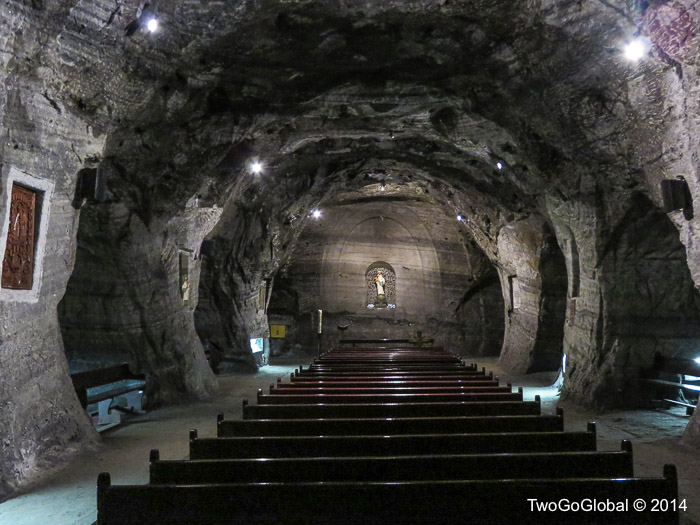Not too much to talk about on this blog as neither of us were enthralled with the mass of Bogota, located on a high plateau at 2625m above sea level, making it the third highest capital city in South America after Quito and La Paz. With over eight million people calling the sprawl home it was a graffiti ridden, hectic, slightly edgy city, not too unlike many other of the world’s capitals. The most popular part of town for travelers tends to be La Candelaria due to its close proximity to numerous museums, the main plaza, cathedral, and a whole bunch of hostels – this is where we planned on calling home for around a week, soon after cutting it short to only two nights after not feeling it!
Arriving at our accommodation, Zohar Hostel, on what seemed like a low key Sunday afternoon we rang the doorbell and were welcomed with a dark, extremely lacking in life, restored colonial house, albeit extremely clean with huge high ceiling bedrooms. We both expected to see Jack Nicholson come running down the corridor or Norman Bates at any moment! When the owner and his family arrived home, we changed our opinion somewhat as he was very welcoming and provided us with information of the areas main highlights, and places to eat.
Our best memory of Bogota actually ended up being the Sunday evening beers we had at the Bogota Beer Company whilst watching Seattle beat San Francisco for a place in the Superbowl. The 10pm walk back through the dark streets of La Candelaria at times felt a little sketchy!
Andrea visited a couple of the museums, including the Casa Botero and Coin Museum, situated close to our hostel, whilst I went out on a four hour bike tour of the downtown area with Bogota Bike Tours. Although not as good as the walking tour of Medellin it still provided some insight into the history and turmoil of Bogota. The only other activity we felt obliged to do was head up to Monserrate, a mountain dominating the the city center of Bogota. Rising to 3.152m, the summit contains a 17th century church and a number of restaurants and tourist facilities. We took the cable car both directions to squeeze the visit into Andrea’s lunch break.
We skipped the only other recommended attraction, the graffiti tour, when we changed plans and left town early.
Our midweek departure from Bogota’s main bus terminal was almost a disaster when I had to get the online bus tickets printed at the Bolivariano VIP counter. As I stood inline Andrea was taking care of our backpacks and small daypacks, or so she thought! Whilst looking at where I was in the line someone had inconspicuously put their bag down right next to my daypack, containing passport, money, camera, GoPro, and other travel items, then discretely grasped the handles of their bag and my pack together – just as they were about to walk away Andrea looked down and saw what was going on and the guy let go and hastily walked away. A very close, potentially very expensive, call!
Villa de Leyva
Another of Colombia’s amazing white-washed towns, Villa de Layva is considered one of the finest colonial towns in Colombia. Around three hours from Bogota it was a perfect stopover for us on the way down from Barichara. Being located so close to the capital makes it an extremely popular weekend destination for tourists, and with its restaurant lined plaza it was easy to see why – the plaza at 14.000 square meters is immense and somewhat devoid of anything except for a lone fountain.
We had two nights here at the very reputable El Solar, our time spent involving a visit to the market, a hike up to the statue of Christ overlooking the town, and a walk to the overrated Casa Terracotta. Other than that we wandered around the cobbled streets staring in at the quaint stores, coffee shops and houses, many complete with white-washed walls, ornate woodwork and flower covered balconies. Low key Villa de Leyva for us was the perfect place to waste a couple of days before moving on to the fast paced Bogota.
Zipaquira
After escaping Bogota a few days early we headed northward again, fortunately only an hour outside of Bogota. We had stayed at an Irish owned guesthouse in Minca, close to Santa Marta, and were encouraged to try out their other guesthouse in Tabio, not too far from Zipaquira. We honored our verbal agreement and met Rocio on a wet Tuesday night, following her the kilometer down a gravel road to her house with all our luggage. Her Emerald Guesthouse was a welcome change, extremely low key and surrounded by fields and rolling hills.
The salt cathedral in Zipaquira was the initial reason for heading in the wrong direction, usually done as a day trip from Bogota, but in our case a half day trip from Tabio. I had walked the 15km from Tabio to Zipaquira, returning by bus, the day after we arrived – I now knew how to hop from bus to bus, and where to walk on the day we visited the cathedral. This was also to be the day that we were getting the overnight bus to Manizales so we were stuck to a timetable!
The new cathedral, actually not a true cathedral due to having no bishop, is buried deep inside the hill of Zipa, around 180 meters underground, and was constructed as a replacement for a far less stable and structurally unsound sanctuary, which due to being in an active mine had to be shut down in 1990. The original cathedral, some 200 feet higher, was carved in 1950 as a place of worship for the miners daily prayers asking for safety before starting work.
January 17th – January 24th 2014






























